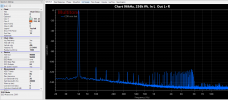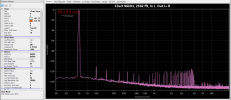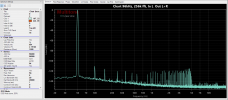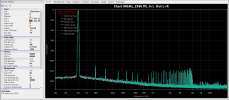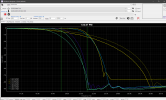| Description | Current (COR min fast) | Brickwall | Linear fast | Linear slow | Minimum fast | Minimum slow | Apodizing |
|---|
| Title | Chart 96kHz, 256k fft, In L Out L+R COR min fast | Chart 96kHz, 256k fft, In L Out L+R Brickwall | Chart 96kHz, 256k fft, In L Out L+R Linear fast | Chart 96kHz, 256k fft, In L Out L+R Linear slow | Chart 96kHz, 256k fft, In L Out L+R Minimum fast | Chart 96kHz, 256k fft, In L Out L+R Minimum slow | Chart 96kHz, 256k fft, In L Out L+R Apodizing |
| Version | Multitone Analyzer v1.0.84 | Multitone Analyzer v1.0.84 | Multitone Analyzer v1.0.84 | Multitone Analyzer v1.0.84 | Multitone Analyzer v1.0.84 | Multitone Analyzer v1.0.84 | Multitone Analyzer v1.0.84 |
| Test Signal | 50Hz sine | 50Hz sine | 50Hz sine | 50Hz sine | 50Hz sine | 50Hz sine | 50Hz sine |
| Test Settings | Gain:-4dB Tones:1 crest=1.4 | Gain:-4dB Tones:1 crest=1.4 | Gain:-4dB Tones:1 crest=1.4 | Gain:-4dB Tones:1 crest=1.4 | Gain:-4dB Tones:1 crest=1.4 | Gain:-4dB Tones:1 crest=1.4 | Gain:-4dB Tones:1 crest=1.4 |
| Sample Rate | Fs(out): 96000Hz/L+R Fs(in): 96000Hz/L | Fs(out): 96000Hz/L+R Fs(in): 96000Hz/L | Fs(out): 96000Hz/L+R Fs(in): 96000Hz/L | Fs(out): 96000Hz/L+R Fs(in): 96000Hz/L | Fs(out): 96000Hz/L+R Fs(in): 96000Hz/L | Fs(out): 96000Hz/L+R Fs(in): 96000Hz/L | Fs(out): 96000Hz/L+R Fs(in): 96000Hz/L |
| FFT | Size:262144 Window:Blackman-Harris 7 | Size:262144 Window:Blackman-Harris 7 | Size:262144 Window:Blackman-Harris 7 | Size:262144 Window:Blackman-Harris 7 | Size:262144 Window:Blackman-Harris 7 | Size:262144 Window:Blackman-Harris 7 | Size:262144 Window:Blackman-Harris 7 |
| Averages | Averages:50 Type:Amplitude Overlap:87.5% | Averages:50 Type:Amplitude Overlap:87.5% | Averages:50 Type:Amplitude Overlap:87.5% | Averages:50 Type:Amplitude Overlap:87.5% | Averages:50 Type:Amplitude Overlap:87.5% | Averages:50 Type:Amplitude Overlap:87.5% | Averages:50 Type:Amplitude Overlap:87.5% |
| Range | 20 - 20000Hz | 20 - 20000Hz | 20 - 20000Hz | 20 - 20000Hz | 20 - 20000Hz | 20 - 20000Hz | 20 - 20000Hz |
| Fundamental | -2.4dBFS @ 49.8Hz | -2.4dBFS @ 49.8Hz | -2.4dBFS @ 49.8Hz | -2.4dBFS @ 49.8Hz | -2.4dBFS @ 49.8Hz | -2.4dBFS @ 49.8Hz | -2.4dBFS @ 49.8Hz |
| Level | -2.4dBFS -5.4dB(rms) | -2.4dBFS -5.4dB(rms) | -2.4dBFS -5.4dB(rms) | -2.4dBFS -5.4dB(rms) | -2.4dBFS -5.4dB(rms) | -2.4dBFS -5.4dB(rms) | -2.4dBFS -5.4dB(rms) |
| TD+N | -101.3dB | -101.3dB | -101.3dB | -101.3dB | -101.3dB | -101.3dB | -101.3dB |
| IMD | -- dB | -- dB | -- dB | -- dB | -- dB | -- dB | -- dB |
| THD | -109dB | -109dB | -108.9dB | -108.7dB | -109dB | -108.9dB | -108.9dB |
| Noise | -109.9dB | -109.8dB | -110.1dB | -110.1dB | -110.1dB | -110.1dB | -109.9dB |
| N+D | -105dB | -105dB | -105.1dB | -105dB | -105.1dB | -105dB | -105dB |
| SNR | 107.5dB | 107.4dB | 107.7dB | 107.7dB | 107.7dB | 107.7dB | 107.5dB |
| SFDR | 114.5dB @ 4532.2Hz | 114.5dB @ 4532.2Hz | 114.5dB @ 4532.2Hz | 114.5dB @ 4532.2Hz | 114.4dB @ 4532.2Hz | 114.5dB @ 4532.2Hz | 114.4dB @ 4532.2Hz |
| ENOB | 17.4 bits | 17.4 bits | 17.4 bits | 17.4 bits | 17.4 bits | 17.4 bits | 17.4 bits |
| Delay | -1.4ms | -2.5ms | -1.3ms | -2.1ms | -2.3ms | -2.2ms | -2.5ms |
| Drift | 0ppm | 0ppm | 0ppm | 0ppm | 0ppm | 0ppm | 0ppm |
| Jitter(peak) | 0ps @ 48Hz | 0ps @ 48Hz | 0ps @ 48Hz | 0ps @ 48Hz | 0ps @ 48Hz | 0ps @ 48Hz | 1692ps @ 30.4Hz |
| Jitter(rms) | NaNps | NaNps | NaNps | NaNps | NaNps | NaNps | 1589.5ps |
| Harmonics | H2:-110.3dB/-99° H3:-116.4dB/-134° H4:-137.2dB/+77° H5:-120.3dB/-123° H6:-136.4dB/+119° | H2:-110.2dB/-99° H3:-116.7dB/-133° H4:-136.4dB/+52° H5:-120.5dB/-122° H6:-135.9dB/+123° | H2:-110.3dB/-98° H3:-116.3dB/-133° H4:-137.8dB/+113° H5:-120.0dB/-121° H6:-137.5dB/+135° | H2:-110.1dB/-97° H3:-116.0dB/-134° H4:-134.4dB/+96° H5:-120.2dB/-122° H6:-136.3dB/+86° | H2:-110.3dB/-99° H3:-116.3dB/-134° H4:-138.5dB/+104° H5:-120.1dB/-123° H6:-136.6dB/+113° | H2:-110.2dB/-97° H3:-116.2dB/-133° H4:-139.5dB/+98° H5:-120.1dB/-123° H6:-136.1dB/+97° | H2:-110.3dB/-100° H3:-115.9dB/-135° H4:-138.0dB/+134° H5:-120.2dB/-123° H6:-135.5dB/+104° |

